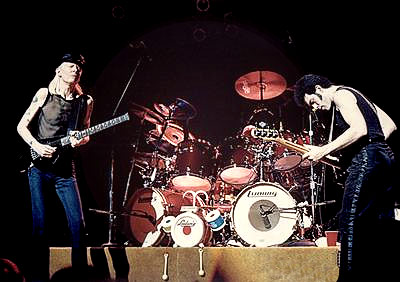Albums Released in 1981
Johnny Winter did not release a new studio album under his own name in 1981. His previous record,
Raisin’ Cain
, came out in 1980 on Blue Sky (Columbia), and his next would not arrive until 1984 (
Guitar Slinger
on Alligator Records). However, 1981 still saw notable album projects involving Winter:
Muddy Waters’ King Bee
Winter produced and played guitar on this Muddy Waters album released in 1981. It was recorded in just three days amid Muddy’s declining health. King Bee featured Waters’ gritty take on songs like “Champagne & Reefer” and the title track “I’m a King Bee,” and it stands as Muddy’s final studio album. The record received generally positive reviews.
Tours and Live Performances in 1981
Winter kept a busy performance schedule in 1981, touring clubs, theaters, and festivals with his hard-driving blues-rock trio. His backing band featured bassist Jon Paris and drummer Bobby “T” Torello. For example, in August 1981, he headlined a show at New York’s Pier 84 as part of the Dr. Pepper Summer Music Festival.
Major Career Events in 1981
Label Transition and Independence: 1981 marked a transitional period in Winter’s career. It was the first year in over a decade that he had no active major-label contract or new release of his own. Free from the major-label schedule, Winter found himself at a crossroads. In mid-1981, Winter formed his own record imprint, dubbed Mad Albino Records.
Musical Style in 1981
By 1981, Johnny Winter’s musical style was a seasoned blend of fiery Texas blues and rock ‘n’ roll – delivered with intensity. Winter was widely known for his high-energy blues-rock albums and live performances, characterized by blazing fast guitar runs and searing slide guitar work.
Collaborations in 1981
Collaboration with other musicians has always been a theme in Johnny Winter’s career, and 1981 was no exception. Notable collaborations included:
- Muddy Waters: Winter’s partnership with Muddy Waters continued, producing and playing guitar on King Bee and performing together at ChicagoFest 1981.
- Sonny Terry & Willie Dixon: Winter recorded an album called Whoopin’ with blues harmonica legend Sonny Terry and bassist Willie Dixon.
- Rick Derringer: Johnny joined his old friend Rick Derringer on stage for a live show at the Savoy in New York City.
Gear (Guitars, Amps, Effects) in 1981
Johnny Winter’s sound in 1981 was the product of both his fiery technique and the distinctive gear he used.
Guitars
Winter’s iconic guitar in this era was his Gibson Firebird electric. He favored a 1963 Firebird V model, which had mini-humbucker pickups that contributed to his biting, high-output tone. He also began experimenting with the Erlewine Lazer, a small custom-made guitar.
Amps
Johnny Winter’s amplifier of choice in this period was the Music Man HD 130, a 130-watt combo amp with 4x10” speakers. The amp’s 4x10 speakers gave a tighter low-end response, and the high wattage meant clean headroom until pushed to the max.
Effects
Johnny Winter was famously sparing in his use of effects. However, he employed a Boss CE-2 Chorus pedal, which he kept on all the time. He also occasionally used a fuzz/distortion pedal or booster for solos.
Other Gear
Winter preferred light-gauge strings (often a .009–.042 set) on his electric guitars, which facilitated his rapid soloing and wide bends. For slide playing, he used a metal slide, likely steel or brass.
In essence, Johnny Winter’s 1981 rig was simple but effective: a screaming Gibson Firebird, a cranked Music Man amp, and a touch of chorus effect to thicken the tone. This setup, combined with his virtuosic skill, produced the relentless waves of sound for which he was famous.








